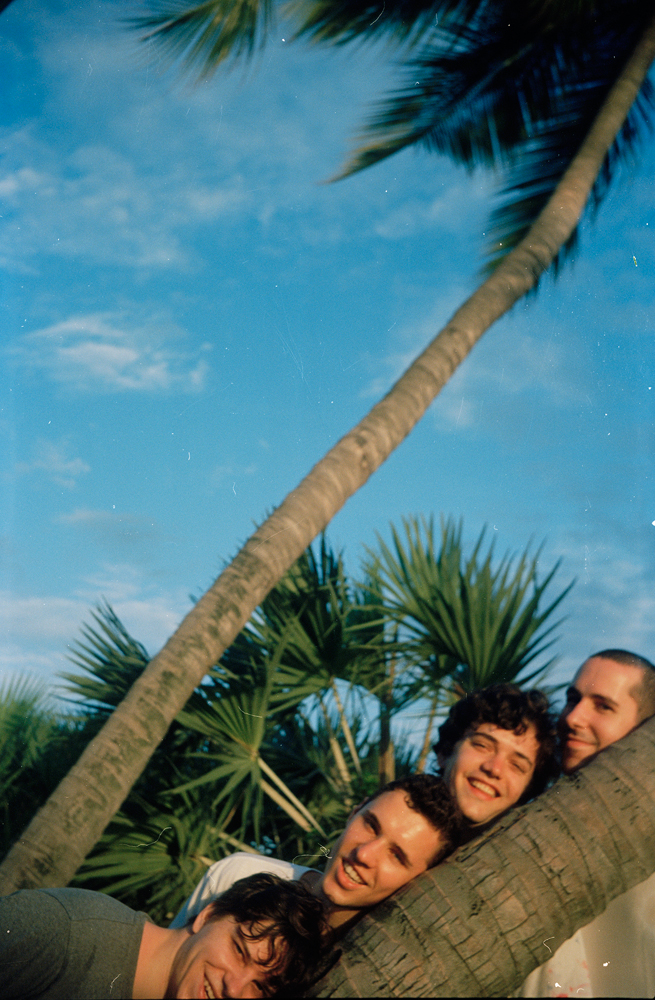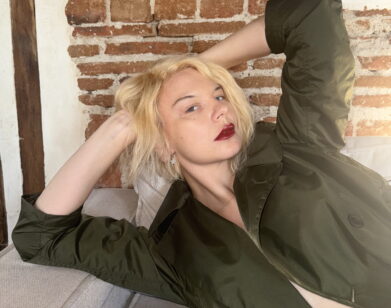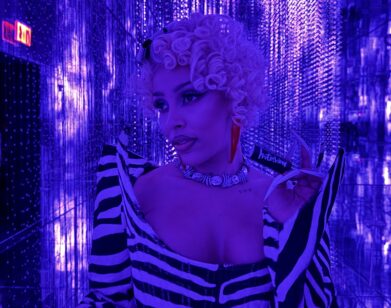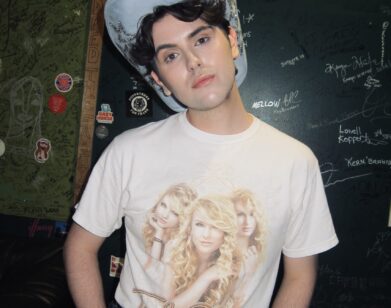BADBADNOTGOOD and Friends

When the band BADBADNOTGOOD took the stage after Sunflower Bean and before DIIV at Brooklyn’s House of Vans, the quartet was a force to be reckoned with. Matthew Tavares, Alexander Sowinski, Chester Hansen, and their new bandmate Leland Whitty meld everything from classical jazz to hip-hop, psychedelic rock, and the slightest bits of electronica, resulting in shows filled with unwavering energy. Tomorrow, the Toronto-based band will release IV, following BBNG (2011), BBNG2 (2012), and III (2012). While last year, they dropped Sour Soul, an entirely collaborative album with Ghostface Killah, IV is the first of their own to bring in vocalists. The record includes a variety of features from Mick Jenkins, Kaytranada, Sam Herring, Colin Stetson, and Charlotte Day Wilson, alongside their signature purely instrumental tracks. As a whole, the album seamlessly traverses every soundscape the band explores, bringing the listener on an all-encompassing sonic journey.
Though the range of vocalists and sounds might seem disparate, they reflects the band’s beginnings: Tavare, Sowinski, Hansen, and Whitty met while attending Humber College’s jazz program. When it came time to play for a panel of performance instructors, Tavares, Sowinski, and Hansen played a composition based upon Odd Future’s music. The panel of professors did not find it entertaining, but it caught the attention of Tyler, the Creator, who promoted a video of the performance, helping it to go viral. From there, the three went on to work with their early supporter, as well as Earl Sweatshirt and Danny Brown. BBNG included a set of covers legends like “Lemonade” by Gucci Mane as well as songs by A Tribe Called Quest and Waka Flocka Flame, among others. Whitty would tour with BBNG and record with his three friends when possible, though he only joined the band full-time earlier this year.
Prior to the release of IV, and just after a soundcheck in Luxembourg, we Skyped with Tavare, Sowinski, Hansen, and Whitty.
EMILY MCDERMOTT: So I know you’ve worked with Leland for a long time, but why was now the right time for him to join the band full-time?
CHESTER HANSEN: Ever since the time we all met, we also knew Leland. We played together in different combinations in school or outside of school. He was always part of the fam. We tried to play as many local shows as we could [with him] and he gradually started playing more and more. We had him by the studio and as of a year-and-a-half ago he’s done everything with us.
ALEXANDER SOWINSKI: We started touring with Ghostface and needed Leland to assist us with guitar because of a lot of the songs required guitar. So he was touring with us and we decided it felt really nice to have a fourth feeling to the show. We asked him to tag along.
MCDERMOTT: With the show, does your set change or do the live versions of your songs change depending on who you’re sharing the stage with?
HANSEN: We try to adapt to a certain audience feel. When we play a jazz festival, a solo is very common in terms of long sections of improvisation. It feels really good. Sometimes we can branch out and play longer in some settings. We don’t necessarily try to alter things; we try to go with the energy and if the energy feels like, “All right, we’ve been here for a while, let’s go elsewhere,” we try to adapt that way. The House of Vans was interesting because it was all rock-based bands, but we try to go with the energy and vibe it out. We do what someone would do if a DJ were spinning all different kinds of vibes: just flow with it.
MCDERMOTT: Can you tell me about the studio you now record in? I saw that you used to work in someone’s basement and now you have your own place.
HANSEN: When we first started, we were jamming in Alex’s dad’s basement—he’s the number one fan of the band—so we did a lot of our early recordings there. When we were recording Sour Soul, when Frank Dukes brought us to New York to record at Dunham Studios—where Menahan Street Band and Daptone used to do their stuff—that spawned our love of analog recording and becoming obsessed with collecting keyboards and old gear. We started looking for a spot and found a perfect sound-proof garage. Us and Frank Dukes share it.
SOWINSKI: And we call it Studio 69. [laughs]
MCDERMOTT: What’s the most recent addition?
LELAND WHITTY: I just bough a bari sax a few weeks ago. That’s probably the most recent addition. Aside from that, we got some CS-60s.
SOWINSKI: We’re a big fan of this Yamaha synth series, so we bought a CS-60 and then Chester’s dad found another one in an estate sale—
HANSEN: –for like one-sixth of what it should cost. It’s a lot of fun to have multiple CS-60s.
MCDERMOTT: This is the first album you’ve had multiple guest vocalists. How did that affect the writing process?
SOWINSKI: It adds a fifth dimension. Everything we’re doing, the stuff we write on our own, we’re trying to create with the interest of having a vocalist or having the lead element be instrumental, whereas if we’re working with someone else, they’re filling that space. We get to hold back a bit and create a beautiful atmosphere for them to do their thing.
HANSEN: Yeah, every feature on the album got the chance to come by our studio. In the past we’ve done a lot of collaborations via email. Having the physical presence, opinion, and vision be assisted by someone who’s supplying something, especially a vocal lead, is really nice because everyone can work together to figure out the sections, emotion, and the dynamics of a song. It helps make it a much easier process.
SOWINSKI: They were all finished in person, [except] we got some assisted Mick Jenkins vocals post-session because we had done so many sections with him on so many different songs. Everything else was started, written, and 99 percent recorded all together.
MCDERMOTT: How did you select the collaborators?
HANSEN: Every collaboration was a little different. Sam Herring was because we did a remix of “Seasons” for Future Islands kind of in exchange for the lyrics. We met up and he agreed to come to our studio and try to write and record some music with us. We had a couple songs with him. “Time Moves Slow” made the album and we have another song that we might release later this year. Then we’ve been doing lots of sessions with Kaytranada; he’s guest DJ’d our shows, so we’ll book a couple of sessions after and write lots of samples and have him play percussion and synths, hear what he’s working on and try to mish-mash different stuff. I went to high school with Charlotte Day Wilson, so with her, it was just like, “Come through and try to write some material.” The song on the album [“In Your Eyes”] came really fast. Colin Stetson was someone we had a connection to through our publisher, and then we’ve been working with Mick Jenkins in the studio every time he’s in Toronto.
SOWINSKI: All of these people are our friends at this point because we’ve done multiple sessions. Everyone gets along really well and the creative process is a lot of fun.
MCDERMOTT: Will any of them make appearances during the tour?
HANSEN: We’ve gotten the chance to do the show with Charlotte a couple times and one video session as well. She’s the easiest to access because she lives in Toronto, but who knows. Down the road we might get to play songs with [the other] people, but until then they’re on the record.
MCDERMOTT: Can you tell me about the song “Chompy’s Paradise”? The saxophone line is amazing and the song has a more R&B vibe than the other songs.
HANSEN: That song is really special and the writing process was really, really fun. Until that point, we didn’t have a song that had that super slow, chill vibe. It heavily features the CS-60 for those sliding effects, and Leland playing a bunch of different stuff is the crazy arrangements.
SOWINSKI: We’d been listening to a lot of Steely Dan and the use of chords throughout their forms and arrangements is amazing. Chordal sections will come out nowhere, so we tried to incorporate a little bit of that. Once we had the base of the song, Leland went in on the sax and experimented with what lines might work, just playing something funky and fresh. We came up with this quarter-tone-y line that had a weird R&B sax feeling. That completed the song.
MCDERMOTT: Who or what is Chompy?
HANSEN: Chompy is Leland. [all laugh]
WHITTY: I used to be a rapper in high school. I went by the name Chompy Lee. [laughs] Since then I’ve stopped rapping, unfortunately. That song was a beachy, vacation vibe, so we thought that name suited it.
MCDERMOTT: What’s one of the biggest things that you think you learned during the making of this album?
MATTHEW TAVARES: We always learn a lot every time we make an album, but how we learn is a natural process. I definitely learned things from recording and we’ve all learned things from playing this material, but it’s not something you can look back on and be like, “We learned how to play this chord.” A general understanding is what we’ve been working on and it’s the same thing with any other record.
MCDERMOTT: Did anything surprise you during the collaborations?
TAVARES: The craziest thing was seeing Colin Stetson do his process in person. I’ve seen him play shows, but to be right next to him in a room, acoustically, and to see him do this circular breathing process and the volume he projects with only his lungs—I’ve never experienced that before. I’ve always seen him at shows; to stand right next to him is insane. It doesn’t make sense how that sound is coming out of him.
MCDERMOTT: I also like the fact that you put the album credits on the cover. Not many bands do that.
TAVARES: Me and my friend designed the cover. It was originally supposed to be the back cover, but as we did more and worked with it, it started to look cool. The cover we were originally working on was more like stuff we’d seen on Pitchfork or a music website or in a magazine. This looked so much like the back of the album and I haven’t seen that used too much [as the actual cover], so we were like, “This would be unique.” That’s the superfluous answer.
The photo was taken in Croatia. We wanted to represent ourselves on the cover. We skirted around that for the last few albums and this album is so different. It’s an amalgamation of everything we’ve done, from features to jazz-sounding music—I don’t know if we can be categorized necessarily as jazz music—so it seemed right to make it as different as possible. The rest of our catalogue is all black-and-white and vague, dark shots. This is the extreme opposite. We’re all on the cover with our shirts off in towels, putting ourselves out there 100 percent.
MCDERMOTT: When you’re killing time while traveling on tour, what are you doing or who are you listening to?
TAVARES: “Broccoli” by D.R.A.M., Arthur Verocai, “One Dance” [remix] by Justin Bieber/Drake, Sam Rivers, the jazz saxophone player. Steely Dan, of course. Norah Jones, Black Sabbath. It’s a whole smorgasbord of stuff.
IV WILL BE RELEASED TOMORROW, JULY 8, VIA INNOVATIVE LEISURE. FOR MORE ON BADBADNOTGOOD, VISIT THE BAND’S WEBSITE.






